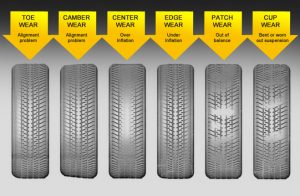 Excessive or uneven tyre wear can be caused by the condition of your vehicle. It is most likely to be caused by the condition of your vehicle in the following 4 areas:
Excessive or uneven tyre wear can be caused by the condition of your vehicle. It is most likely to be caused by the condition of your vehicle in the following 4 areas:
1. Steering and wheel alignment
If your steering is off due to misaligned wheels uneven pressure will be applied to the tyres on your vehicle. This can lead to uneven and excessive wear in different areas of your tyres.
2. The suspension
Issues with the suspension can cause your wheels to become misaligned, itself a cause of excessive and uneven wear. It can also apply uneven pressure to your wheels and cause excessive or uneven tyre wear directly.
3. A faulty braking system.
If you have worn down brake pads you can cause damage to your car’s rotors. This can cause the wheels to run hotter causing excessive wear. Bad brakes can also cause damage to your suspension and cause them to come out of alignment causing uneven tyre wear. If breaks are more ineffective, stopping will also be harder causing more damage to your tyres.
4. Improper tyre inflation
Improper inflation of your tyres can cause excessive or uneven tyre wear. This is true both above and below the recommended pressure level. To avoid this be sure to adjust tyre pressure when carrying heavy loads and check it regularly.
How can you prevent excessive or uneven tyre wear?
If you notice the tread is wearing on your tyres in different parts to others you may have an issue with your brakes, steering, suspension or tyre pressure. To avoid this, you should service your car regularly. Regularly is usually considered to be every 12,000 miles or every year, whichever happens first.
Theory Test Question
Did you have a go at the theory test question: What can cause excessive or uneven tyre wear? Let’s look at each of the answers and check your understanding:
A faulty exhaust system
Wrong! A faulty exhaust system is not usually a cause of excessive or uneven tyre wear.
A faulty braking system
Correct! If your braking system is faulty you can cause excessive and uneven tyre wear. Faulty brakes can damage suspension, tyres, and lead to your wheels becoming misaligned. Each of these things can also cause uneven tyre wear.
A faulty gearbox
Wrong! A faulty gearbox should not cause excessive or uneven tyre wear.
A faulty electrical system
Wrong! The electrical system consists of the battery, starter, and alternator. If this is faulty your car will likely not start and it is not usually a cause of excessive or uneven tyre wear.
References
In section 14 of the official DVSA guide to driving, it states:
Checking the condition of your tyres
- Check that the walls of the tyres are free from cuts and bulges.
- Check that all your tyres have a good depth of tread right across and all around them. The legal requirement for cars, vans, trailers and caravans is no less than 1.6 mm tread depth across the central three-quarters of the breadth of the tyre and around the entire outer circumference. However, it’s recommended that you replace your tyres before this legal limit is reached.
- Have the wheel alignment and wheel balance, suspension and braking system checked regularly. If there’s a fault, have it put right as soon as you can, otherwise the wear on the tyres will be excessive or uneven.
- If you see that parts of the tread are wearing before others, seek advice. This can indicate a tyre, brake, steering or suspension fault.















